The new sailing season is slowly but surely starting and for me this is a kick-off of a special kind. Rather than hoisting a sail my first “wet” delivery of a new boat (a Beneteau Oceanis 35.1) is to be made by travelling some 260 nautical miles from her winter storage which is situated in the middle of Germany in the nice town of Muenster to the Baltic coast where the boat is to be delivered to her new owners.

Why in the middle of Germany? Well, my company is situated down there and prices for winter storage are well below the average rate at the marinas of the coast. Besides, having the boats in our showrooms means to have them available for clients and potential buyers to have a look at them during winter time. In the end, it is really worth the efforts of bringing the boats down and up again from here.
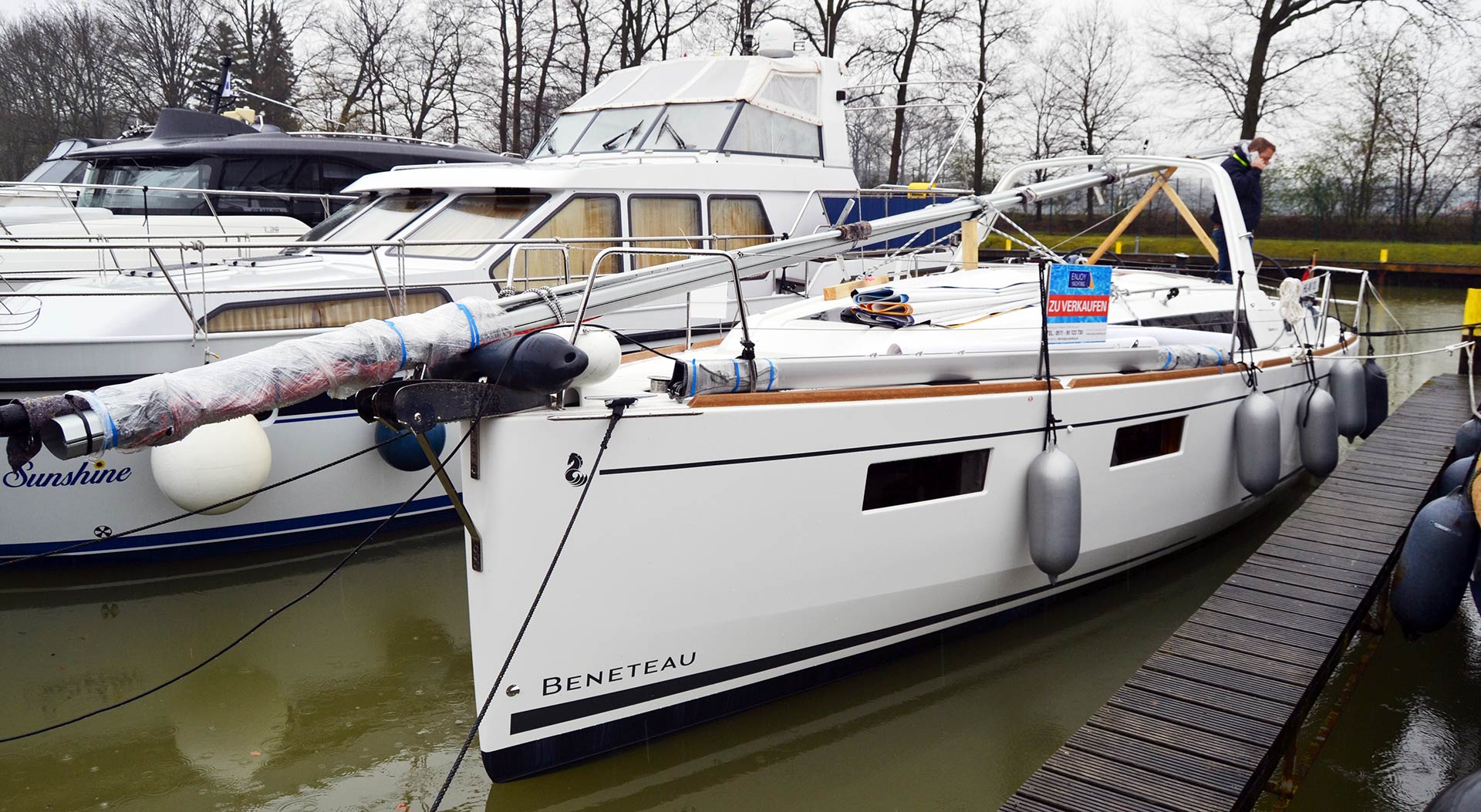
So it´s a cold and misty morning when my “First Officer” of Max arrives at 8.00 a.m.. I was sleeping aboard the night before spending my time in studying the route and checking my knowledge back from the days when I was making my skipper certification – rules and requirements for sailing the German inland waterways are slightly different from those of the open seas. When Max arrived I offer him the voluminous aft cabin of the boat and we prepare the boat for casting off.
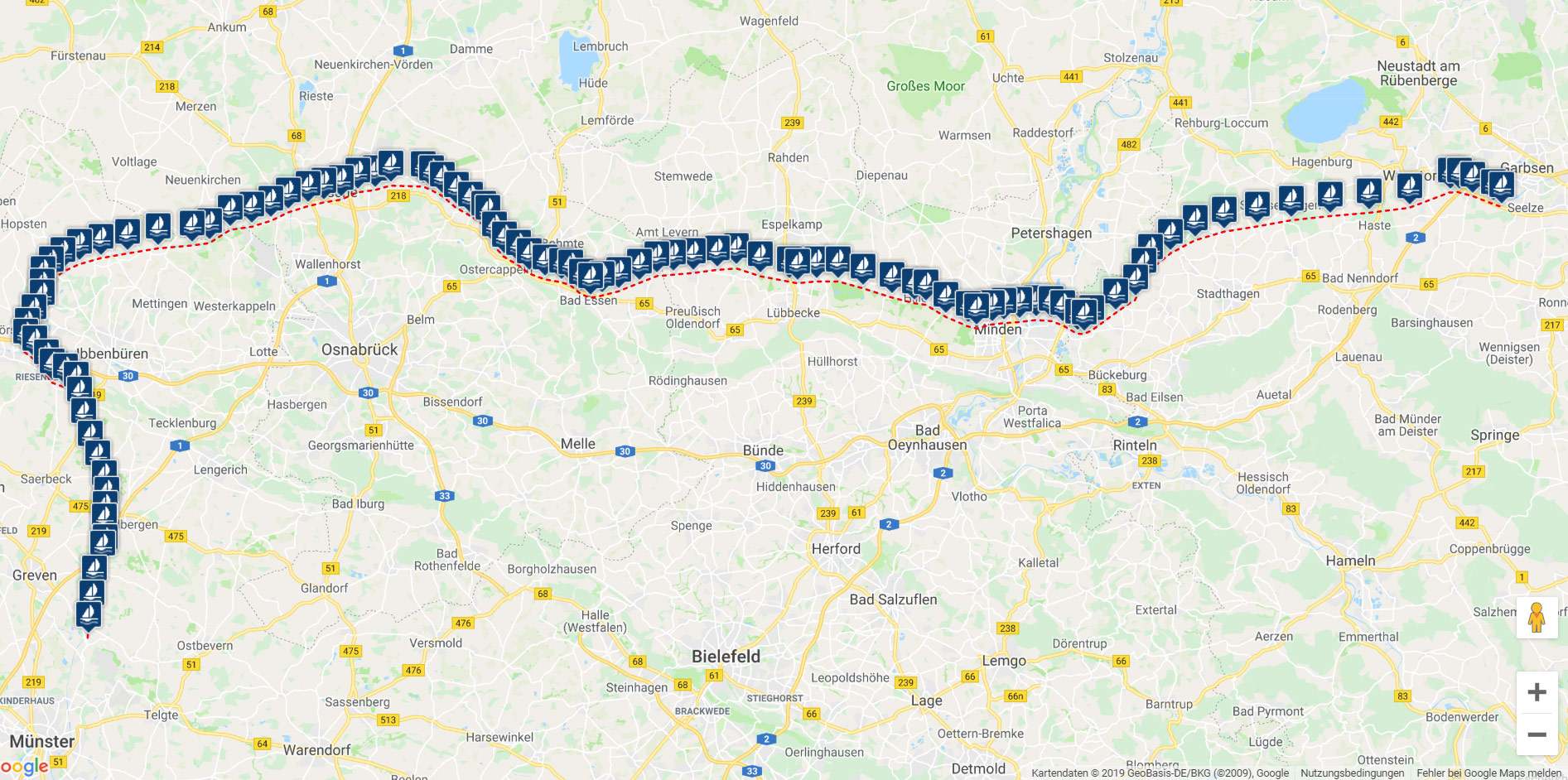
With Max I am going to do the first leg of the 3-legged inshore delivery trip: Ahead of us is the Dortmund-Ems-Canal which is connecting the latter two rivers. The calculated distance is some 95 nautical miles (it will be 96.5 miles according to the log) with no locks to pass. So for me it´s a smooth entree into the world of being a riverboatman. For Max on the other hand it´s an old hat: He was raised (and supposedly conceived) on a power boat and since he is living and based in Muenster sailing on the channel is nothing new for him. So in a way, my First Officer is far better qualified than me. I am willing to learn …
Getting accustomed to inland water sailing
Leaving the berth is wonderful: There is barely any wind, no current and no waves so that the boat can be manoeuvered with ease. When I hit the lever and the Oceanis 35.1 goes to one third speed ahead, we leave the marina in Muenster and head onto the channel. Although spring is in full bloom on the trees, weather isn´t that good – just ten minutes into the trip and after handing over the wheel for the first watch to Max the skies open up and a downpour sets in.
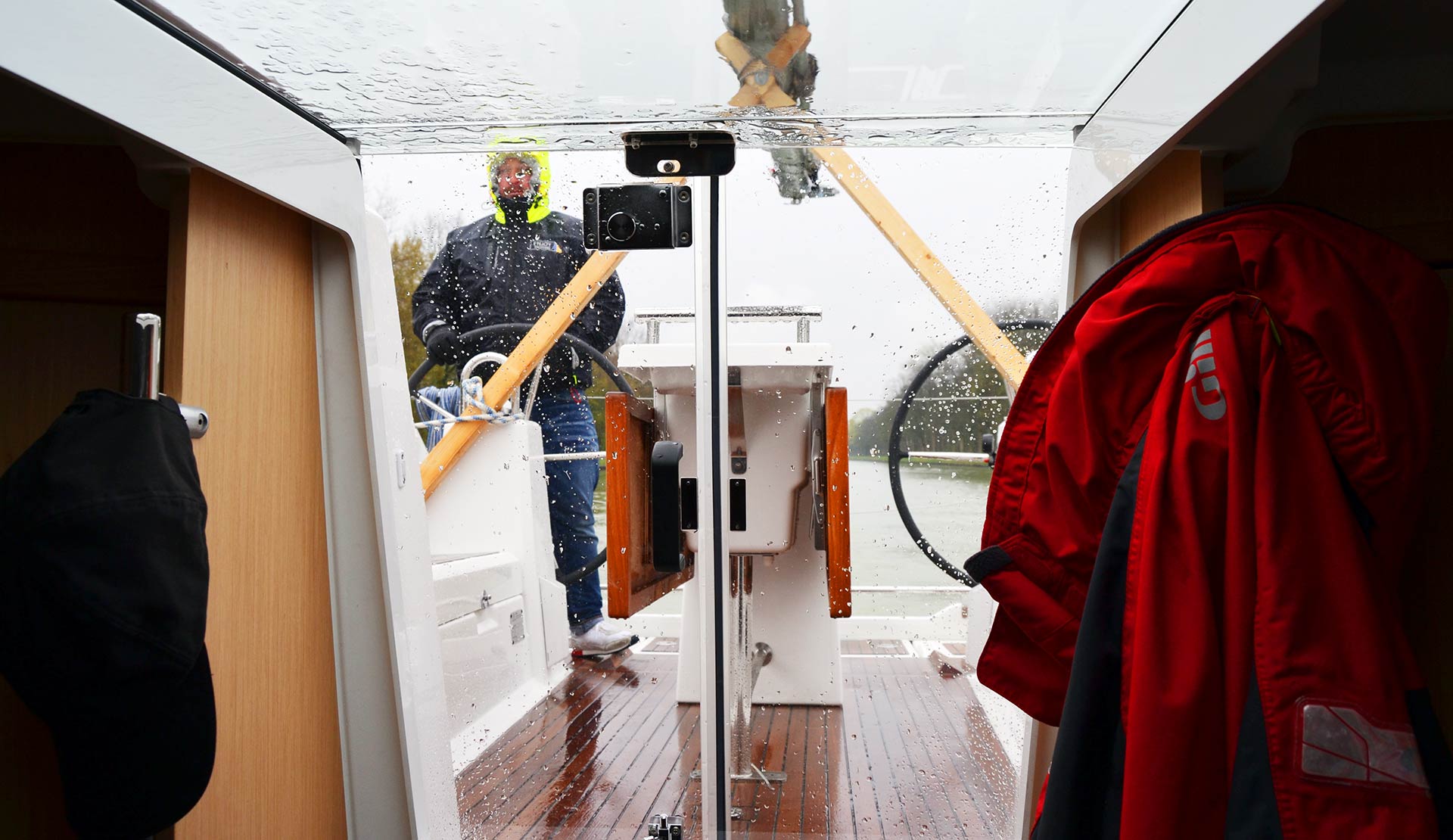
The log says it´s “Rain. 8 degrees Celsius” when Max takes over the wheel at 12 o´clock. It´s coming down hard and before I can learn something from Max, he is taking his first lesson in sailboating: After one hour starting my own watch he says, half smiling, half cursing: “I completely messed this up! I forgot that a sailing yacht is steered from outside …” I look down and pity his wet feet: No oilskin, no sailing boots or anything waterproof. Well, his first push is the heating system which he puts to full steam and 25 degrees Celcius. From this point on we call the boat our “Finnish steam sauna”.
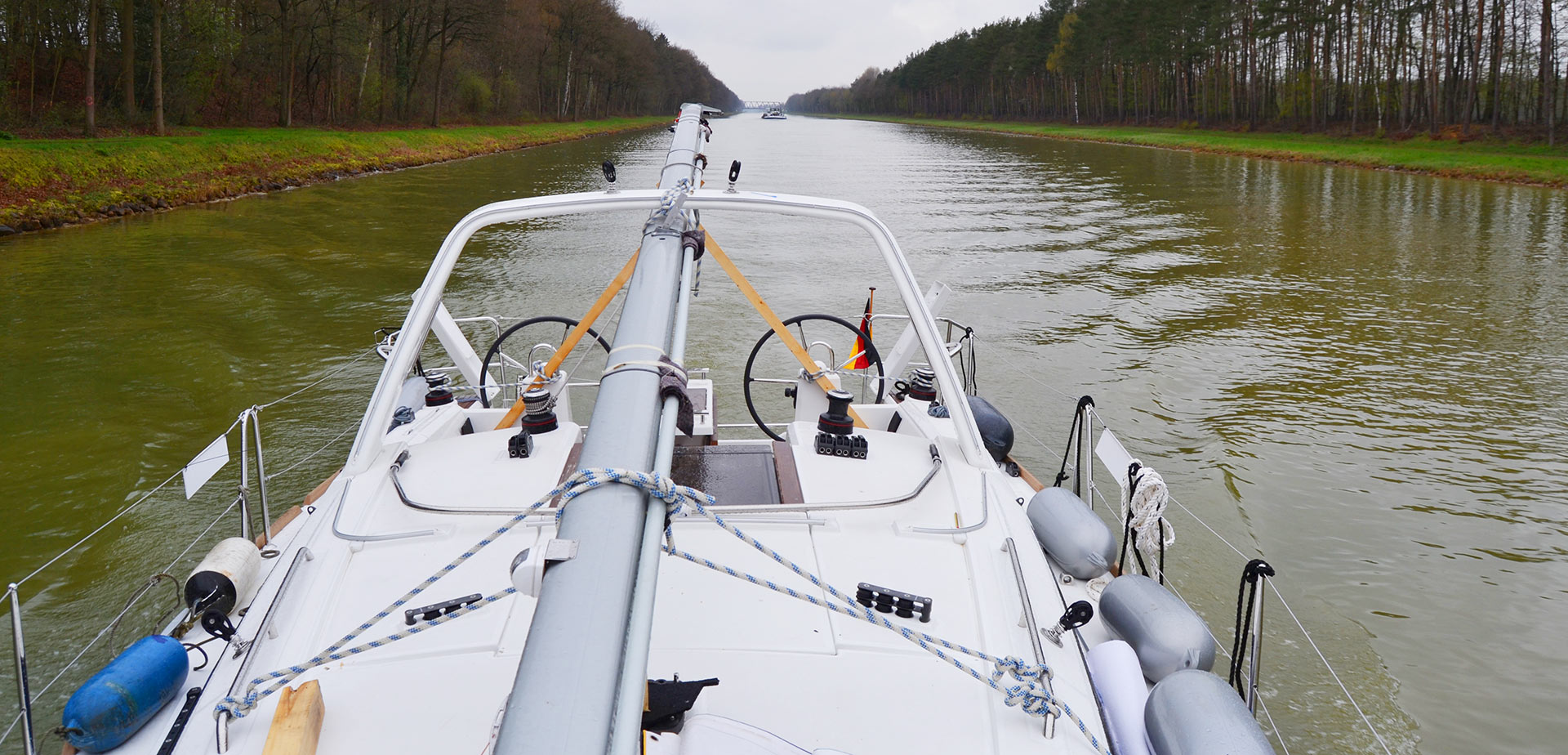
Taking on the wheel I remain in the rain and we agree on a one-hour-shift system which turns out to be the best choice. As our boat isn´t fully rigged nor have all the electronic systems been commissioned completely we cannot utilize the self steering autopilot system: So we have to be constantly steering by hand. Which is by the way the second lesson for Max: Accustomed to power boats he is excited about the accurate and steady course keeping of a sailboat compared to the whiggle-woggle of a powerboat at slow speeds. Nevertheless, it´s really tough to be at the helm full time. So we try to deviate ourselves from the stresses by … doing fun stuff.
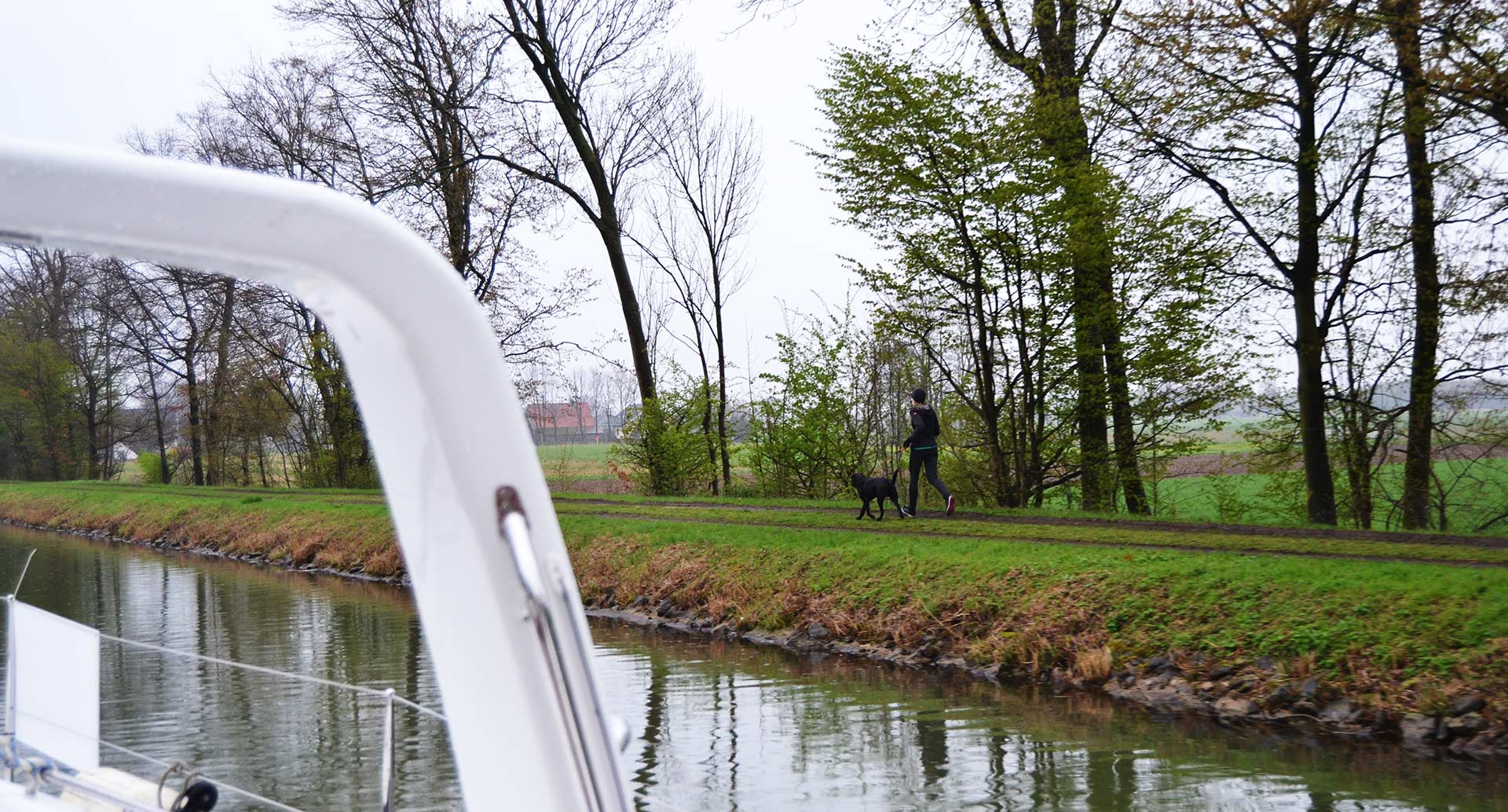
On German inland waterways there´s a speed limit of 10 kilometres per hour, which would be 5.4 knots. You have to avoid eddying and swell on the levees which keep the canals tight, but Max tells me that a speed of 6.5 knots can be done. Later I will learn that even more is common practice here. But even at 6.2 to 6.3 knots, which is 2.200 rpm of our Yanmar Diesel engine, the boat isn´t really “fast”. It takes me almost my entire watch to catch up to a jogger and to overtake her – but only because she had to stop once in a while to call her dog to catch up with her. Well, that was a victory for me. On the other hand it was big fun when two schoolboys with their mountain bikes had no problem in overtaking me. I guess it´s a question of perspective …
Inland water vessels – how to tackle commercial traffic (without VHF)
Since I am constantly working on myself to becoming a better skipper I was especially keen on our encounters with commercial traffic on the canal. I heard quite some stories of riverboatmen being mean and ruthless, shouting at pleasure craft skippers, pushing them away or behaving in bad manner. Nothing of this, I can happily say, did apply. I am generally of the opinion that a seafarer should be acting under the notion of avoiding risk and stress for himself and the other people around him. And this is how I behaved on the canal as well.
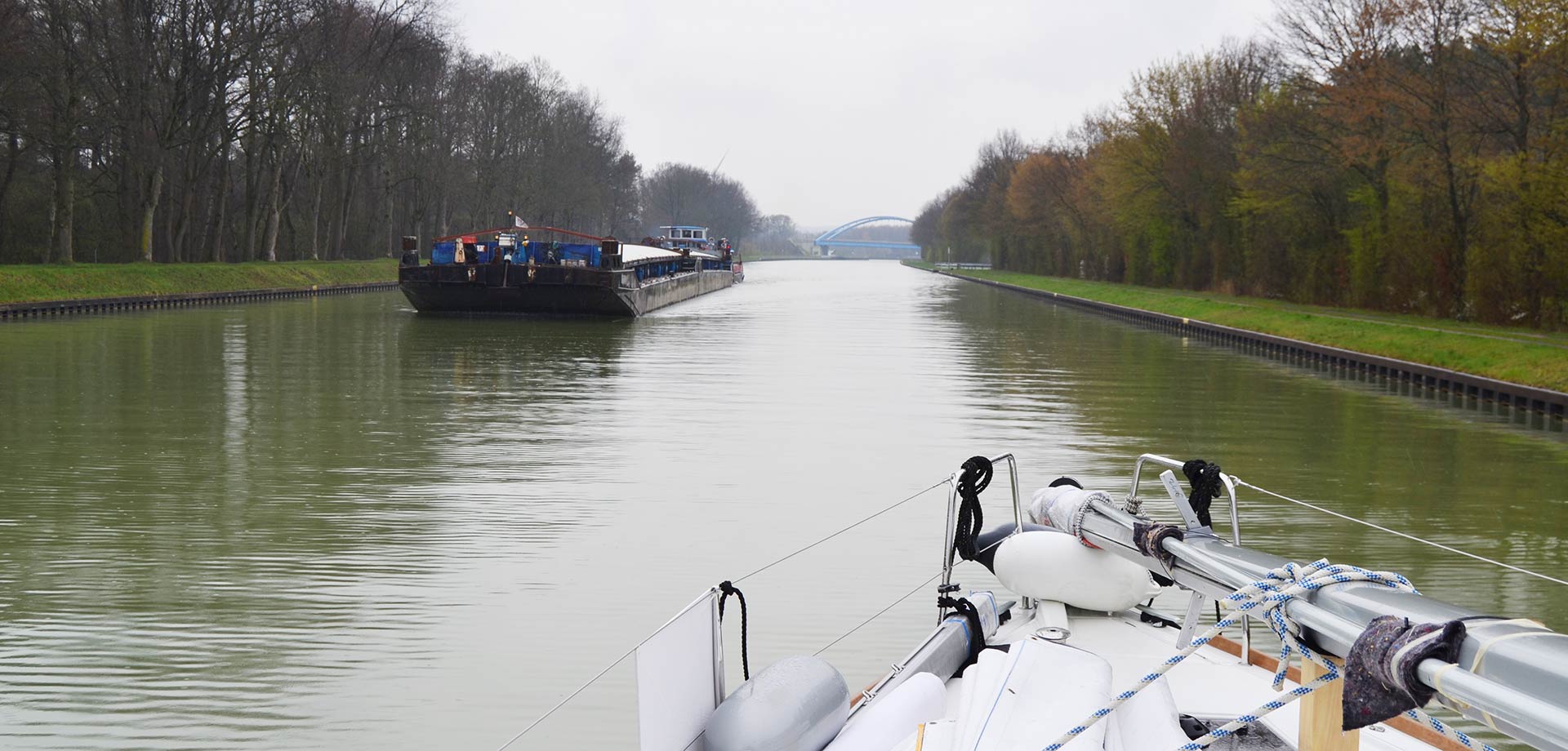
So when an inland vessel approached me I steered well to my right hand side of the channel to make way for the bulky and ponderous vessels. Raising my hand and waving a “Hello” was always met with a bright smile and a wave too by the professional sailors. I´ve had no problem whatsoever on the whole trip so far and I can tell you, we´ve met a minimum of 20 riverboats per day.
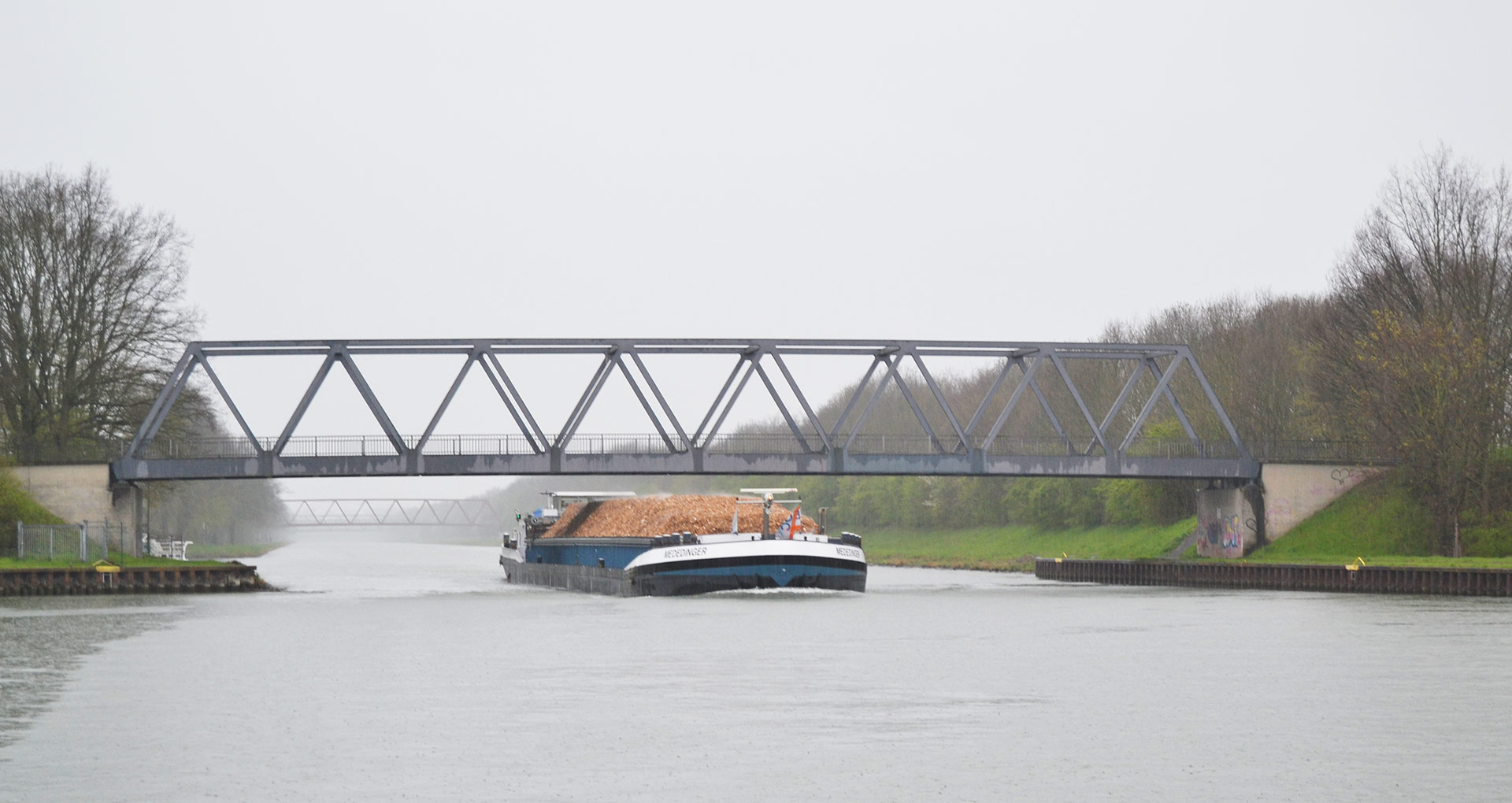
Meeting such a big vessel on the relatively narrow canal is always exciting. The riverboats are pushing a wave of water ahead of the bow which can cause trouble if there is too little space between the passing boats. Even when there´s 4 to 6 metres between the ships, I could well feel my bow go up and the “slide down” the mighty bow washes of the passing ships. Running along the up to 100 metres of the hull is then quite calm until the ship has passed you and the tiny sailboat enters the whorled waters of the wake. Wow, a boiling bowl of water this is! The canels are no deeper than 7 metres so the mighty ship´s screws push back quite some heavy amounts of water – some of those will hit the ground soon and be reflected to the surface. The result is a boiling wake that can extend some 200 metres behind the riverboats still causing strange currents and strong wakes. Exciting!
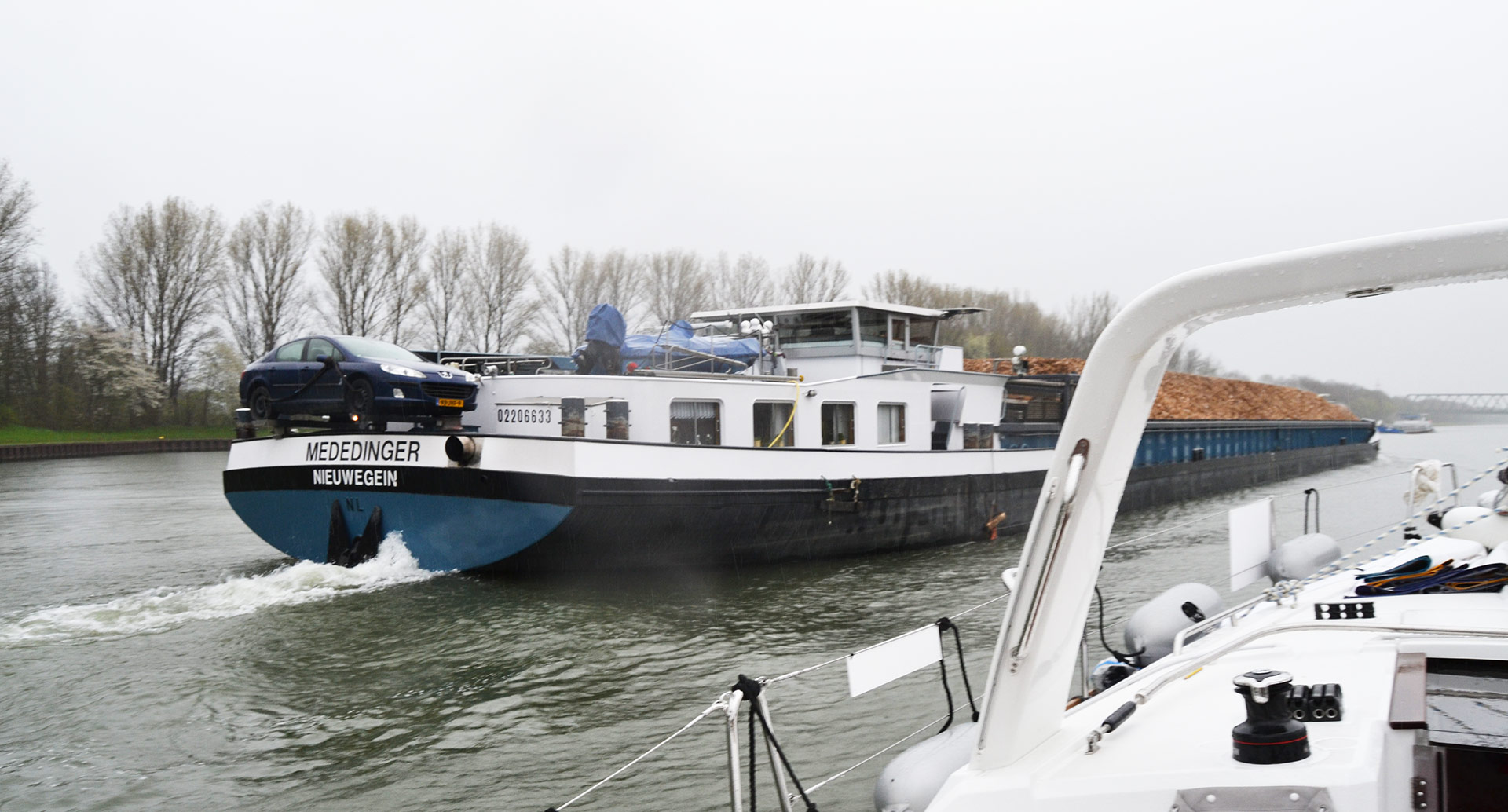
When a riverboat was catching up from behind, I did have a different strategy. Because these boats were not really faster than me, let´s say, 0.3 to 0.5 knots, I imagined that the process of overtaking me with 6.8 knots (over my 6.3 knot) could take minutes and cover a long distance, I always avoided this stress for both skippers and did either a “loop”, meaning that I slowed down, did a 180 degrees turn, passed the ship, turned around again and increased speed again. Or when I entered an area where a cut-out, a harbour or a mooring was situated, I pulled over, slowed down and let them overtake me.
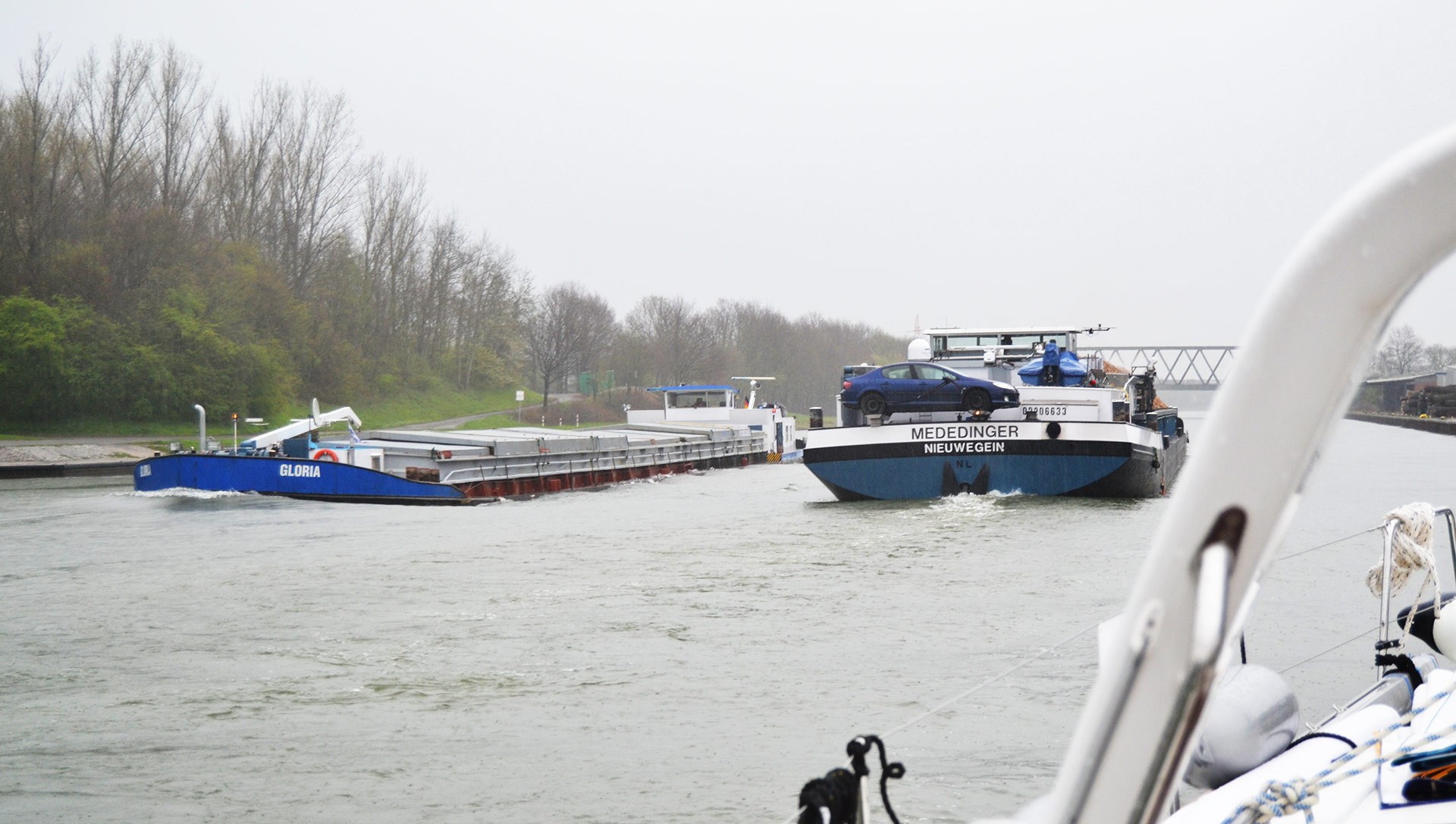
That didn´t happen all to much, let´s say 5 times in 2 days, but every time I did this manoeuvre I was greeted with gratitude, thumb up and a warm waving hand by the riverboat´s captains. The key is to do these things in a bold and clearly visible manner so that the other captain can quickly understand what you have in mind – since my yacht didn´t had a standing mast and the handheld VHF was due for being taken aboard in two days I was depending on this custom. And it worked very, very nicely!
Boring? Adapt and learn something new!
So, indeed, time was flying and I must say contrary to my fears that travelling on the channels might be boring it wasn´t quite as expected. It changed: Being up on watch at the helm the time was flying by like nothing. One hour on watch felt like 15 minutes. There was something to do almost every time, be it course corrections, be it tree branches to avoid or commercial traffic. I was astonished everytime Max punched his head out of the sauna and announced the change of watch. Different story down below though …
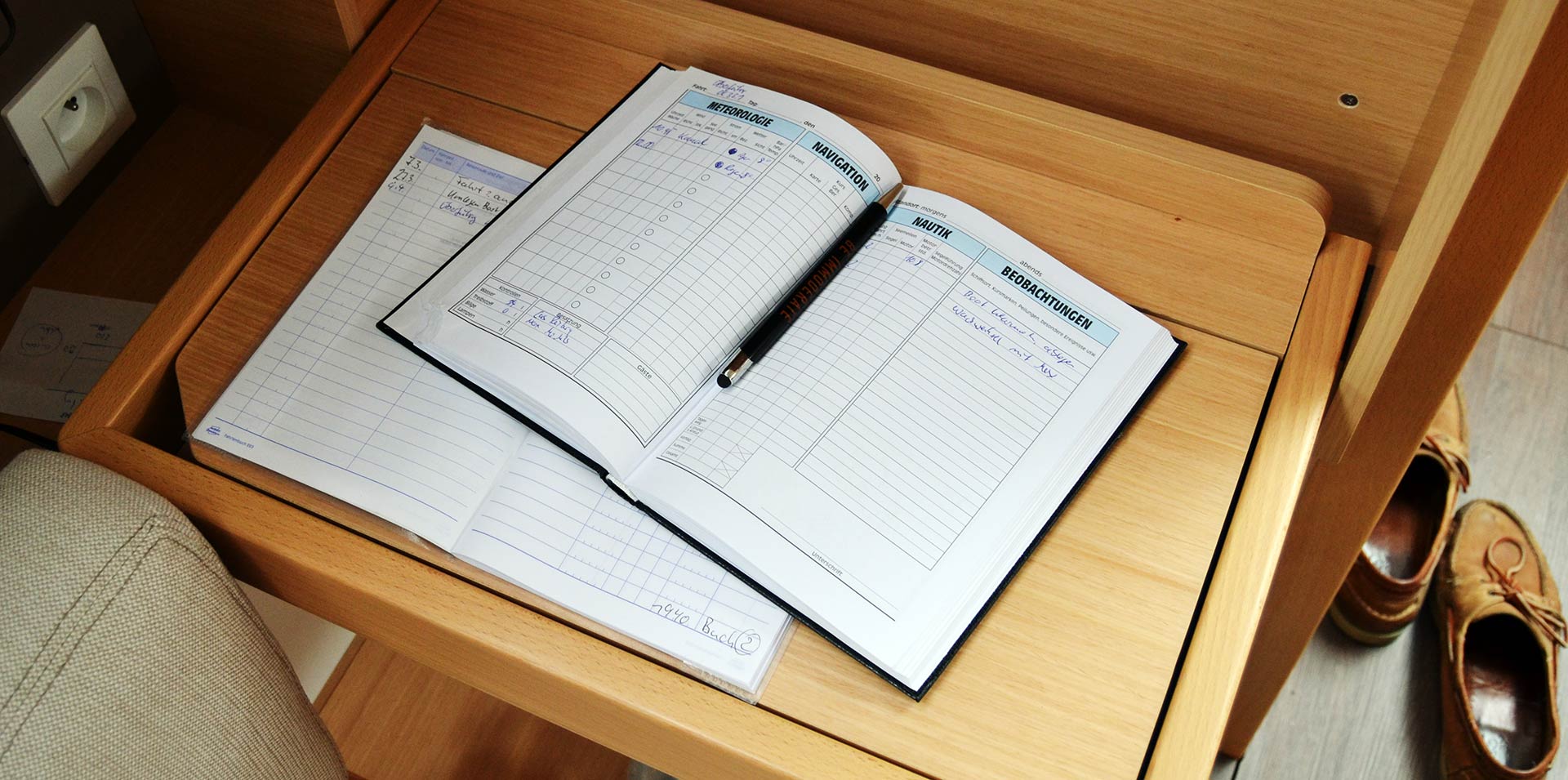
Whereas on high seas sailing time seems to shoot by during watch below, it´s exactly the opposite as well whilst inland travel. Time is like chewing gum down here and one single hour seems to be never ending. Apart from the fact that Max´s 25 degrees Celsius-setting on the powerful heating system of our Oceanis is melting the chocolate (!) in the galley, it´s really nice to have it that warm down here. I use my time to keep the logbook updated – even when we are not offshore I stick to my own rules in accurately writing down the stuff into my log.
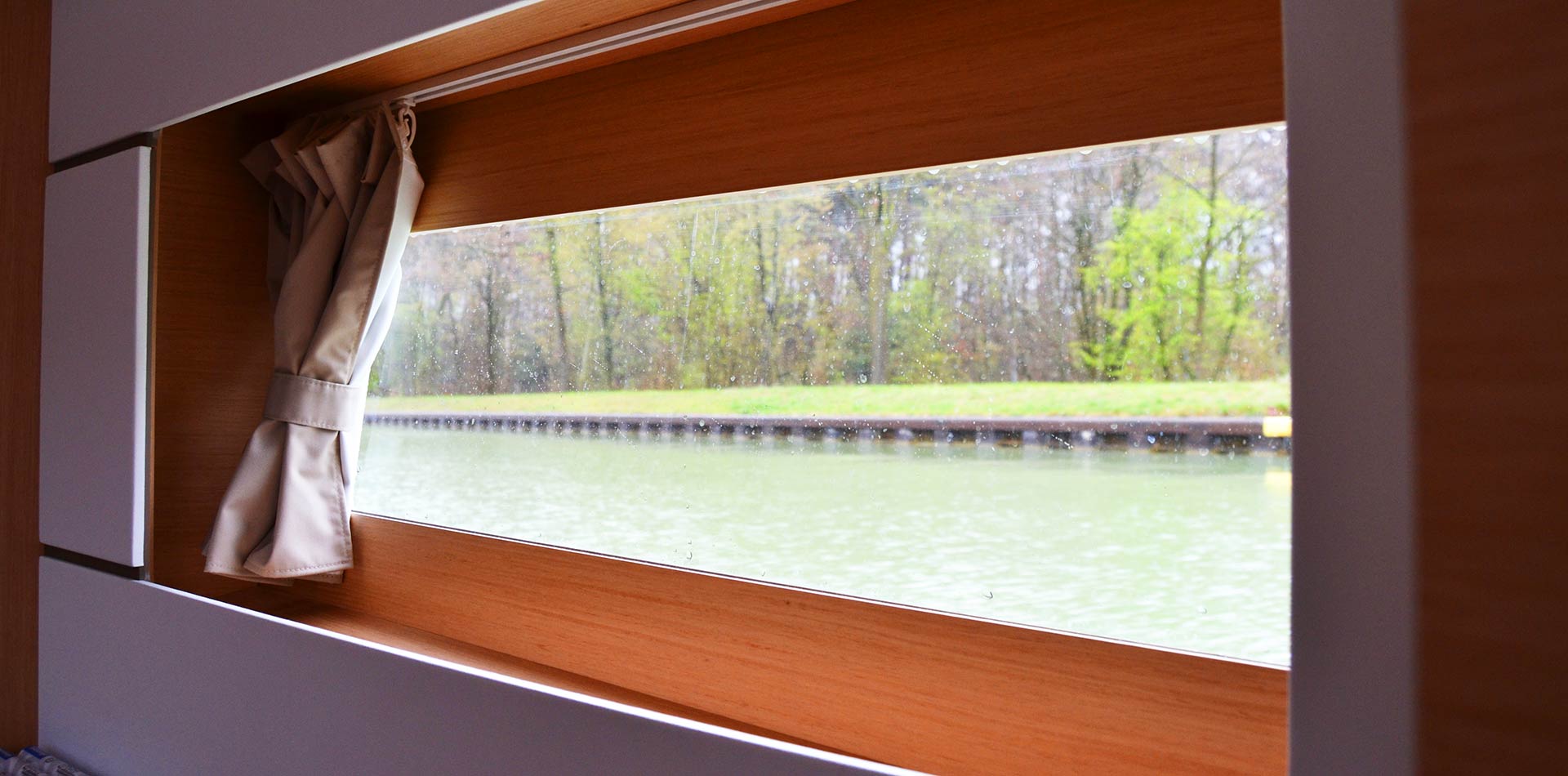
Sleeping is possible, at least a nice maunder of 20 of 30 minutes. I miss the constant seesaw of a ship ploughing the waves but the gentle course corrections by Max up there will at least make my head shake a little. I dream myself away, the humming of the Yanmar helps to drift off. The fact that Germany has an embarrassingly low level (if not to say catastrophic!) of network coverage most of the time there is no phone nor internet connection, so time goes by even slower. Which is very relaxing by the time …
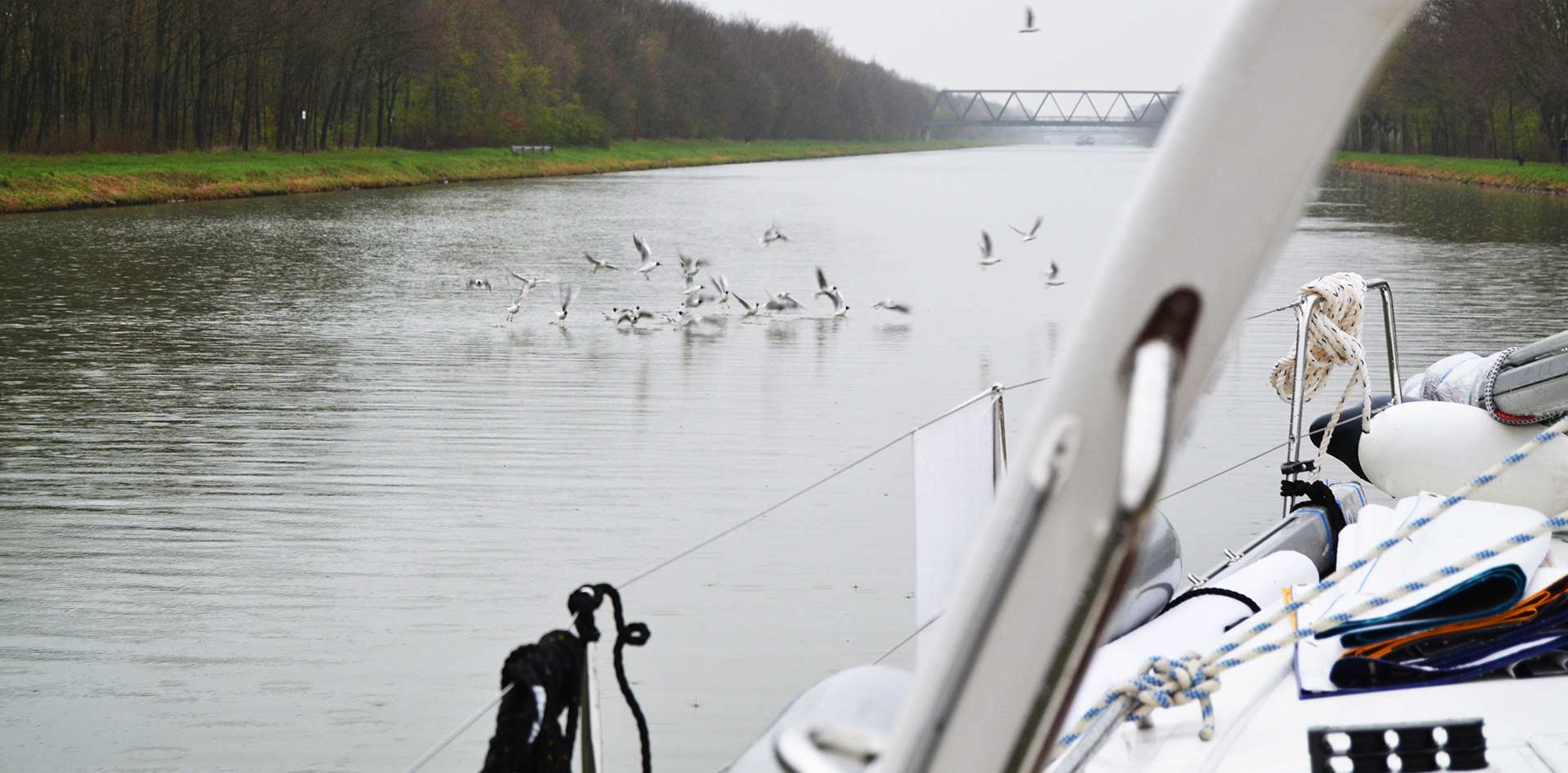
When I am up I am astonished by the rich wildlife. Sometimes the boat is passing through thick forests where I can smell the scent of fresh tree gum and the rich moisture of the green lush and thick moss. I can hear deer roar and watch lots of birds. There are seagulls (in the middle of Germany!), large cormorants and quite some birds of prey flying around. On one occasion I even can see a huge fish coming to the surface and dive down again. And this crossing of Germany is in addition a quite historic event as well.
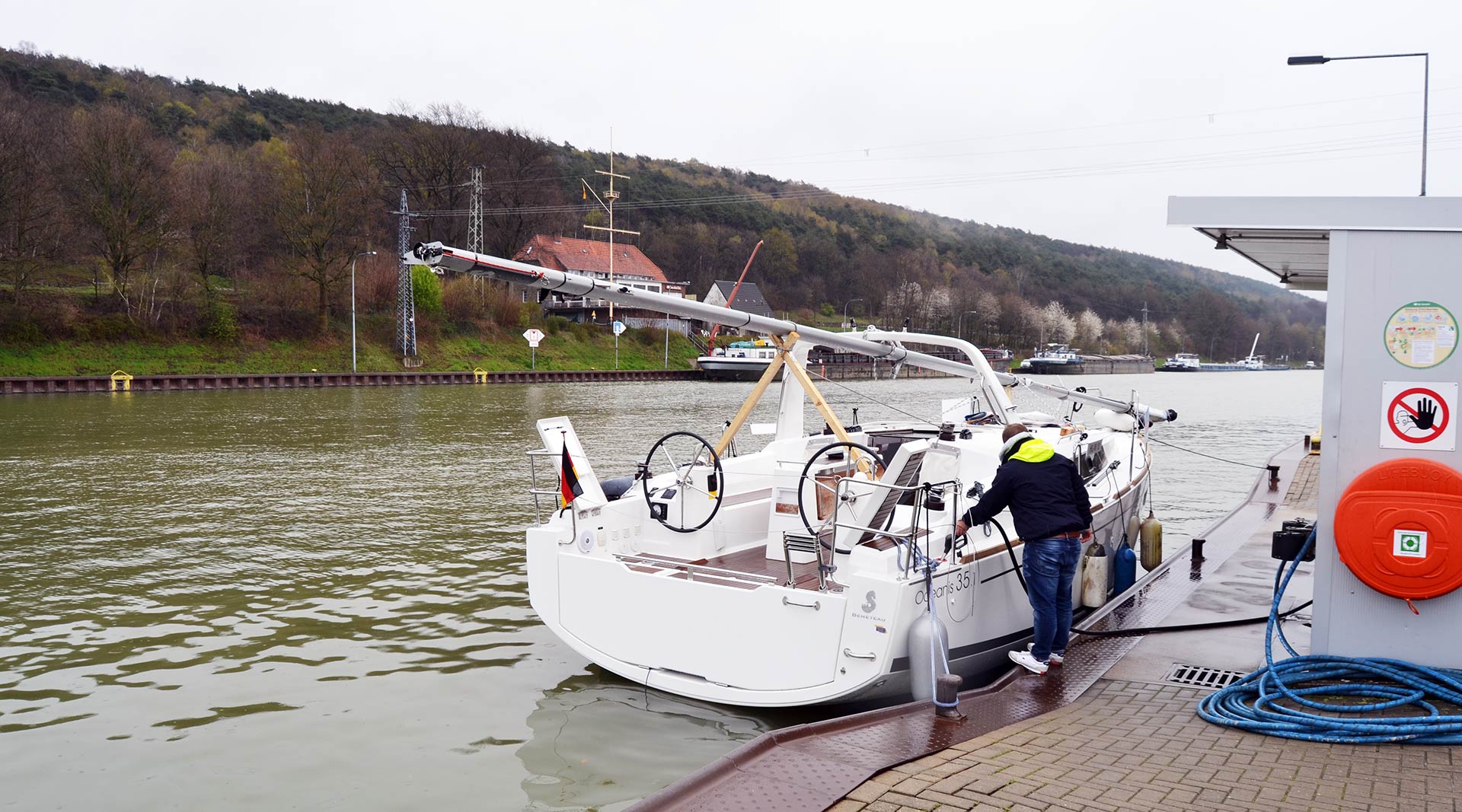
Right when we land alongside a refuelling station I realize that we are indeed standing on soil that beared a seismic shift in world affairs: Looking against the drawn-out front of a massive mountain chain I understand that it was here, where the romanized Arminius led a coalition of Germanic tribes against the legions of the Roman Empire under Varus. All along the way with those mountains covered in impenetrable thick forests to their left and deadly swamps to their right, Arminius slaughtered thousands of Roman soldiers of the occupation troops chasing them to their deaths. This “Battle of the Teutoburg Forest” marks the first real blow to the Roman Empire and the beginning of the decline of their grip on Europe. I am excited!
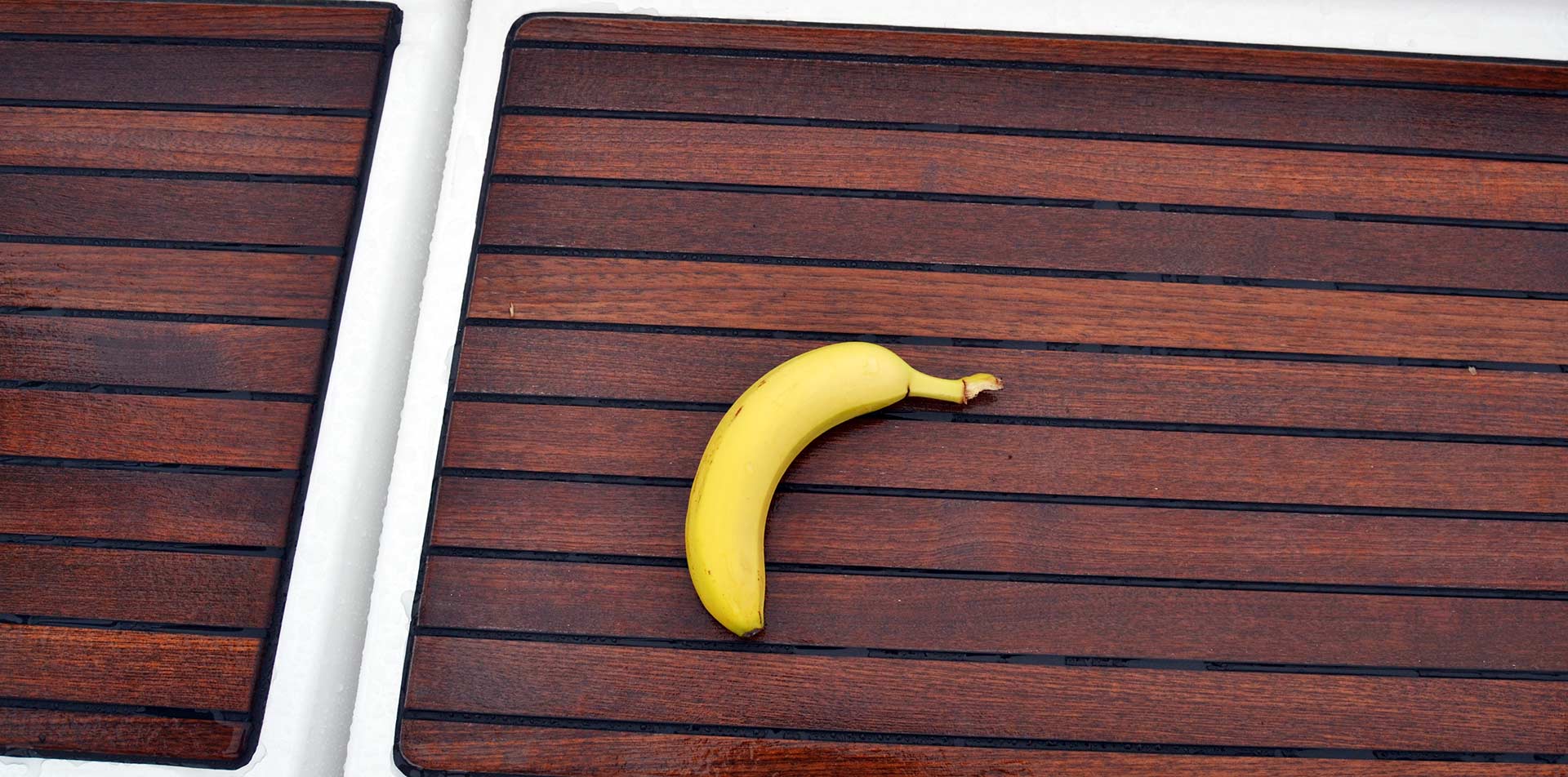
A little less excited on this trip is the onboard cuisine on the other hand. I don´t know if those poor hounded Roman soldiers had a similar diet but due to the fact that our Oceanis 35.1 was a brand new boat that was recently sold we of course didn´t put the galley to use. So our diet consisted of chips, bananas, chocolate (if not molten) and dry bakery. Not even hot drinks like coffee or tea could be served, which would have surely been a treat due to the still cold 8 degrees Celsius. Well …
Mooring on the canal – an adventure of its own
Night was approaching and due to the fact that we could leave no sooner than 10.45 a.m. that day we changed watch last time at 18.30 p.m. and were looking out for a safe place to stay. Well, it´s the same with marinas with sailing on the high seas except the fact that we must had have a save berth for the night for our boat was neither equipped with VHF, nor with Radar or did we have a suitable ship´s light. We didn´t even had proper position lights so it was customary to have the boat tied up over night.
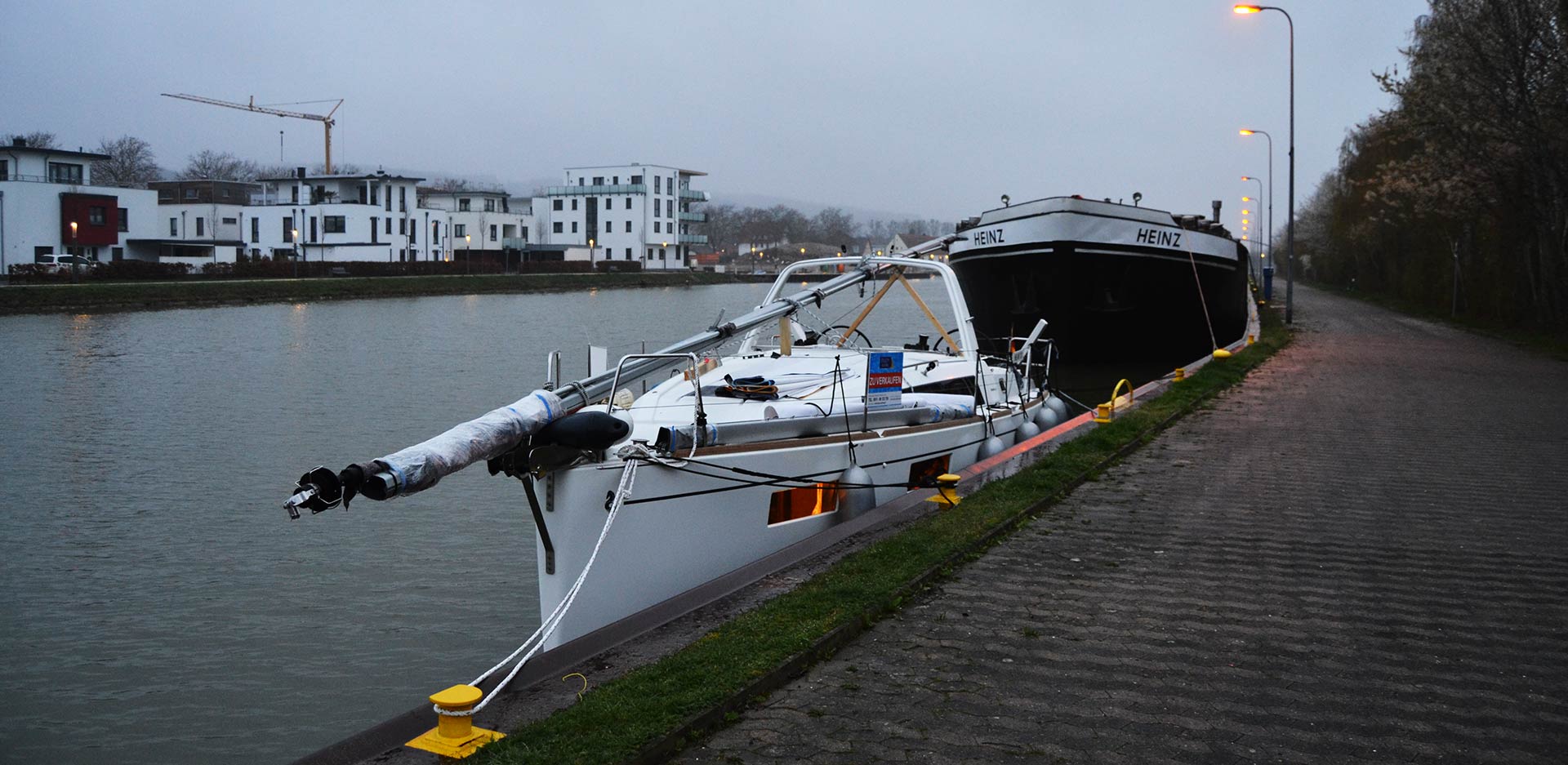
We found a nice place in Bad Essen, a small town not far from where the Roman Empire was beaten. I decided to not go into the marina but instead to have the boat moored alongside a steel piling with three large inwater vessels tied up behind us. Of course, there wasn´t any electric shore power nor facilities here, but I was surprised how calm and nice it was staying here over night. Germany´s canals feature loads of such steel piling walls with possibilities to have the boat moored – it´s done for the commercial shipping but mostly a little part of the walls are reserved for pleasure craft.
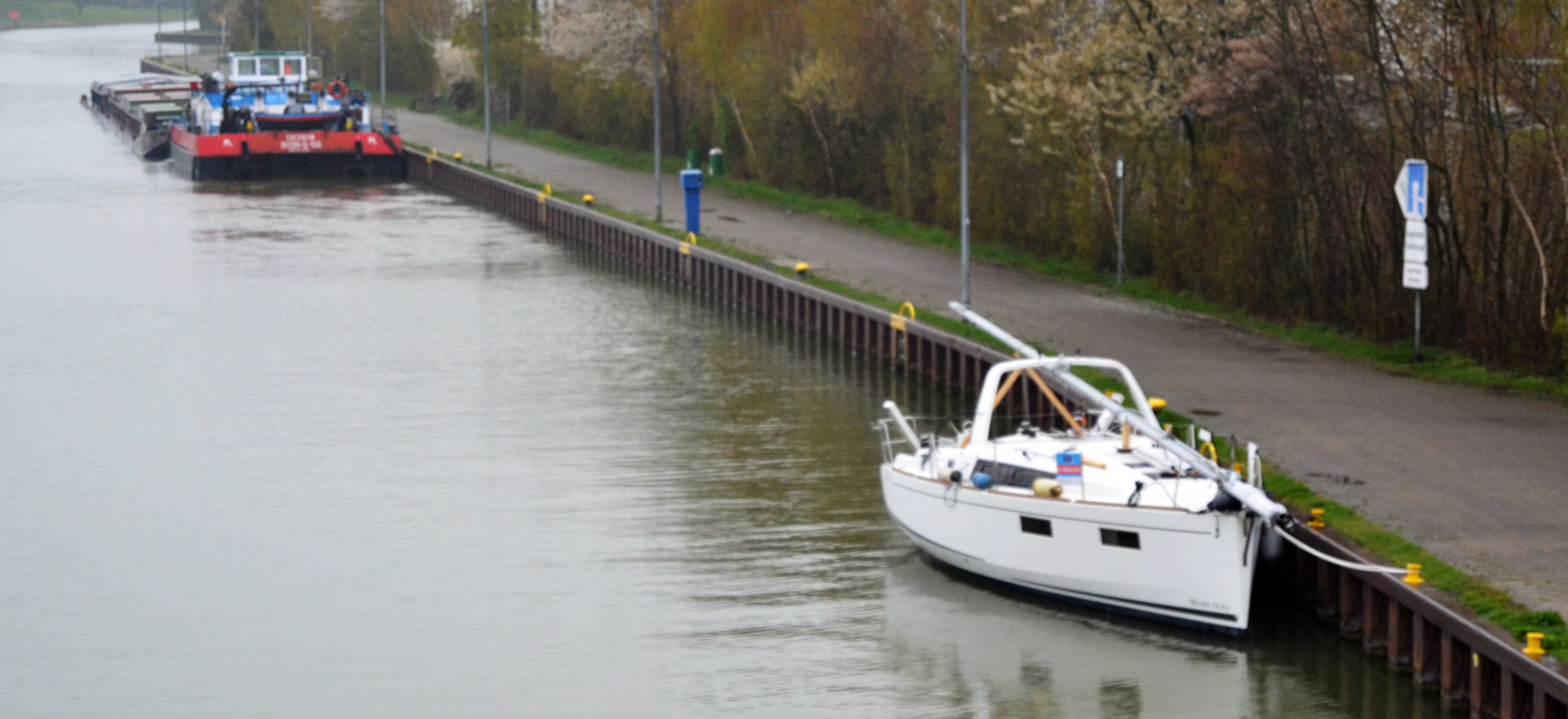
Since the large commercial craft have their own generators and thus power supplies, there is no such things for pleasure crafts. Nevertheless, Max tells me that most of the inwater powerboats also have their own 230 Volt power supply. So in travelling the inwater channel systems a good skipper might plan ahead where these pilings are just like we do on the seas in having a Plan-B harbour anytime at hand in case something happens.
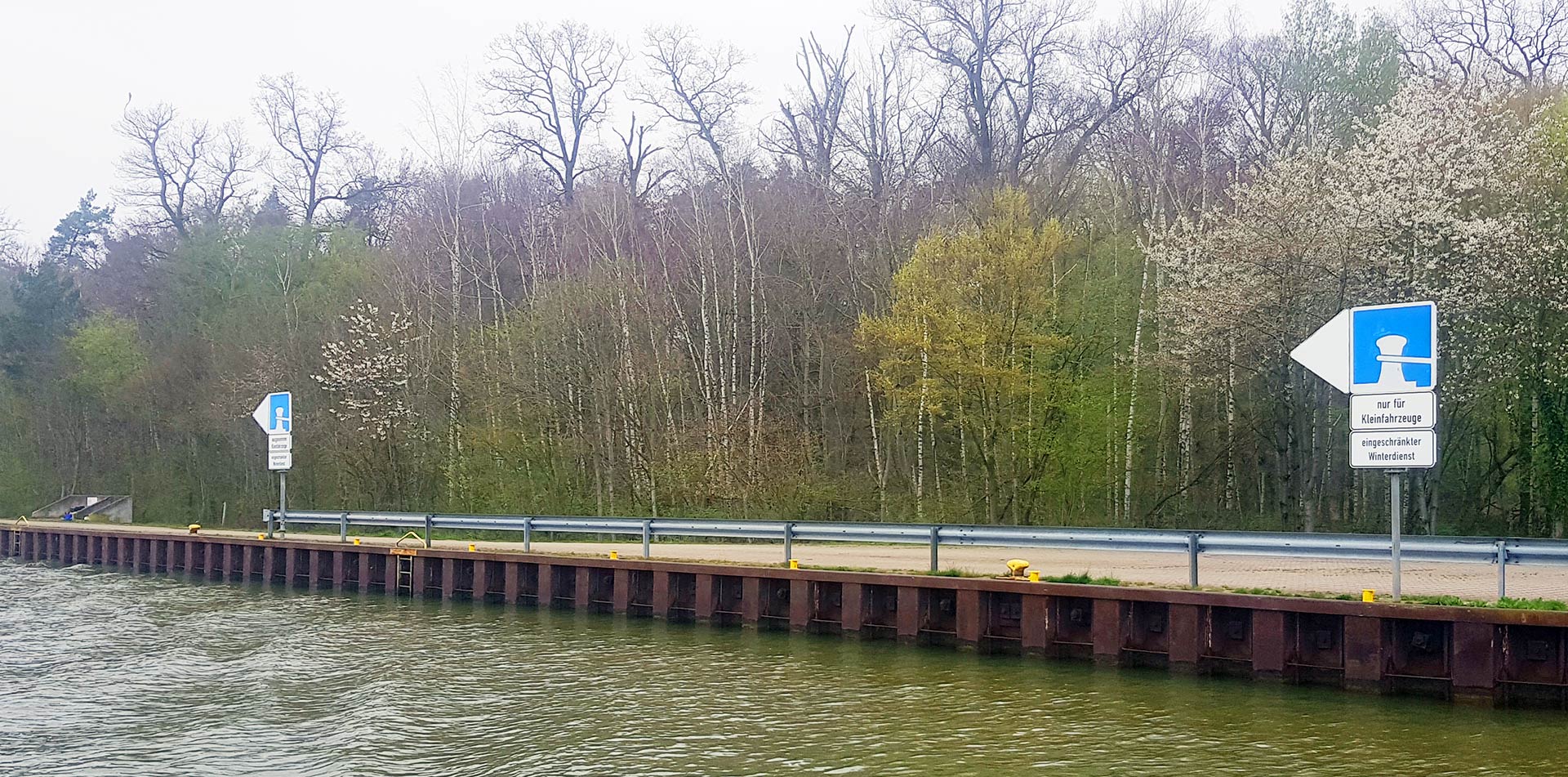
Well, there was a proper staffed and brand new marina in Bad Essen indeed: All berths had been unoccupied except of one, shore power at each single jetty and brand new facilities like WC and warm showers available – just across on the other side of the canal. Why I decided to not to go there? Well, our Oceanis has a draft of 1.56 metres (she is equipped with the shallow draft keel). The sign at the marina said the basin was 1.70 metres deep. That makes a clearance of just 14 centimetres below keel. A stone, debris, an old bicycle – anything higher than the height of a coffee mug would have damaged the boat´s keel!
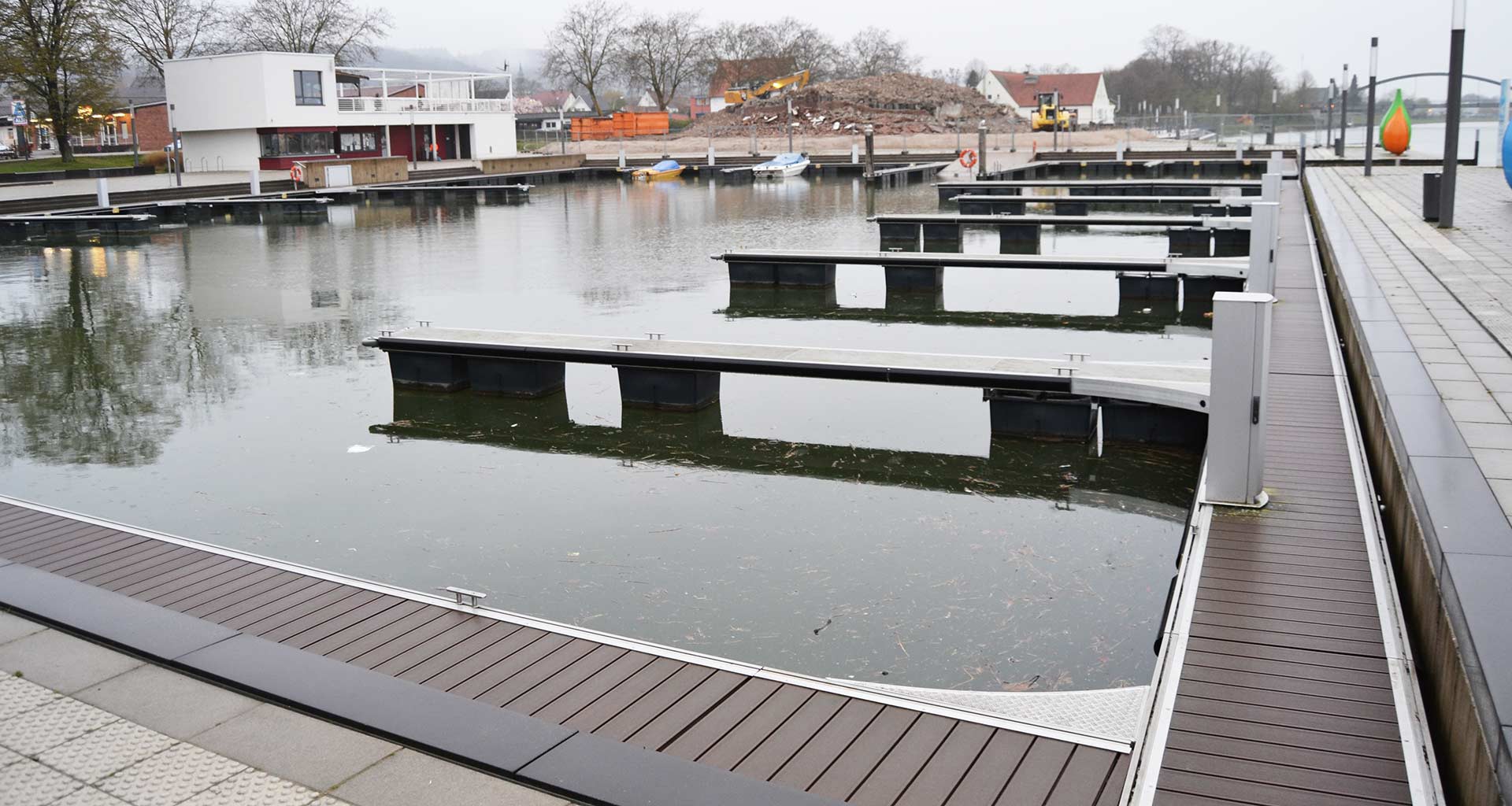
Not to mention the suction of a big inland water vessel passing the marina! Following the big bow wash each ship is also creating a trough that will make the water level sink of 50 to up 70 centimetres – and this suction can happening so fast that I didn´t even want to imagine the consequence that a sudden grounding of “my” yacht would have had to the plastic hull and the keel bolts! “A good sailor is a cautious sailor” is the saying and so I remained outside, which made me sleep deep and calm.
Ready for the next step: Locks and Ship´s Lifts
Next day was a no-brainer. I felt like I was getting accustomed to inshore sailing and the passing of ships, the loopings and out-manoeuvering of vortexes wasn´t of any concerns anymore. We passed the beautiful town of Minden and approached Hannover, the end of this first leg, very fast. The logbook of this second day has no other entries than the in-time change of the watch every hour. All in all, after casting off as early as 8 a.m. we witched the helm eight times. Then we reached a big stepstone of the travel – the Hannover Junction to the North.
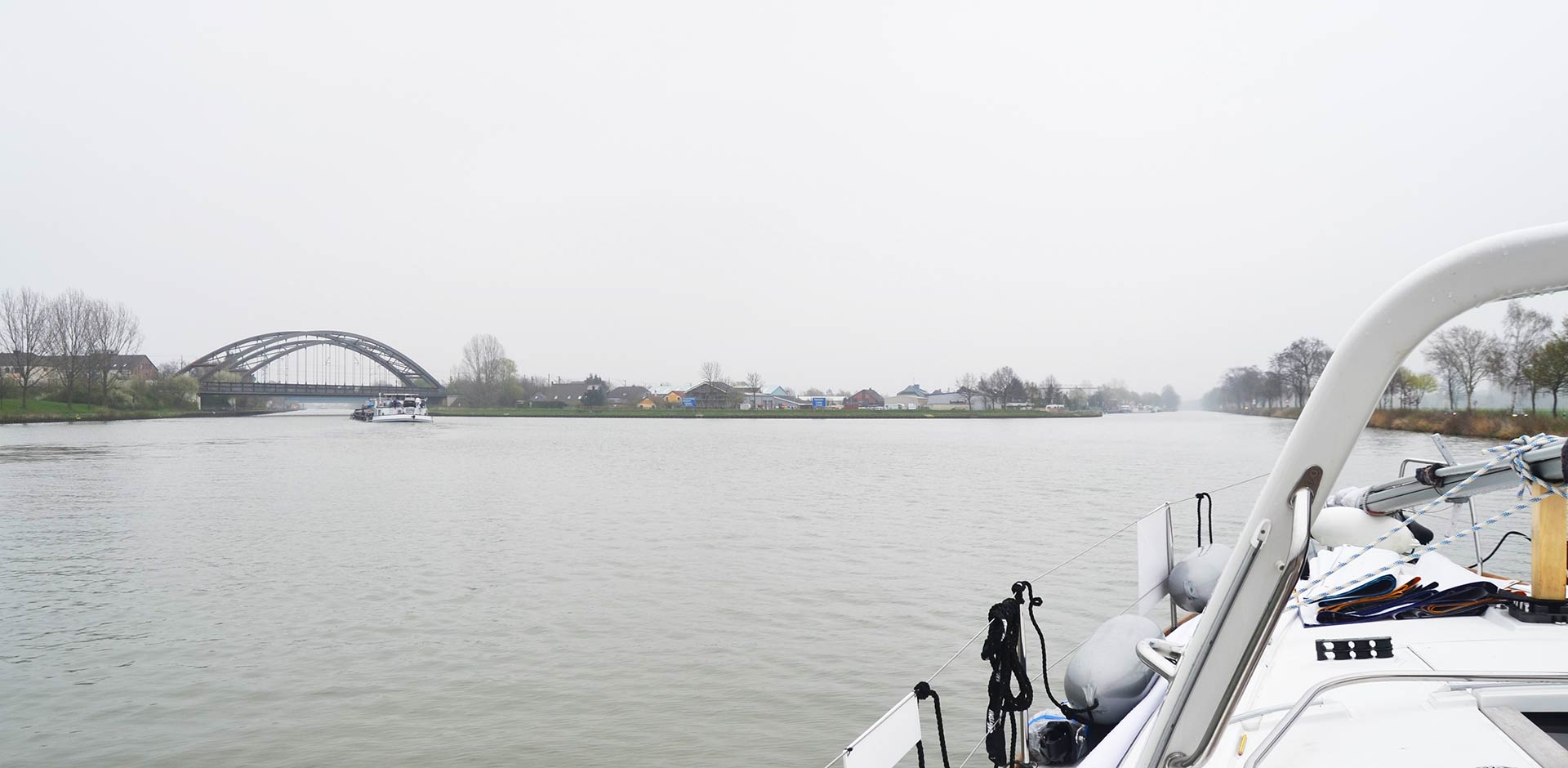
This time we went to the right to have the boat tied up for the weekend, but I will return aboard the Beneteau in a matter of days to tackle the second – and by far the most exciting! – leg of the trip. Heading further north, we will have another 150 miles to go but the level will increase. So you, fellow reader, can be looking forward to no less than eight locks of every size and difference in height and one ship´s lift, mastering a height difference of 38 metres. By the time of it´s build, it was the world´s largest ship´s lift. I am really looking forward to this!
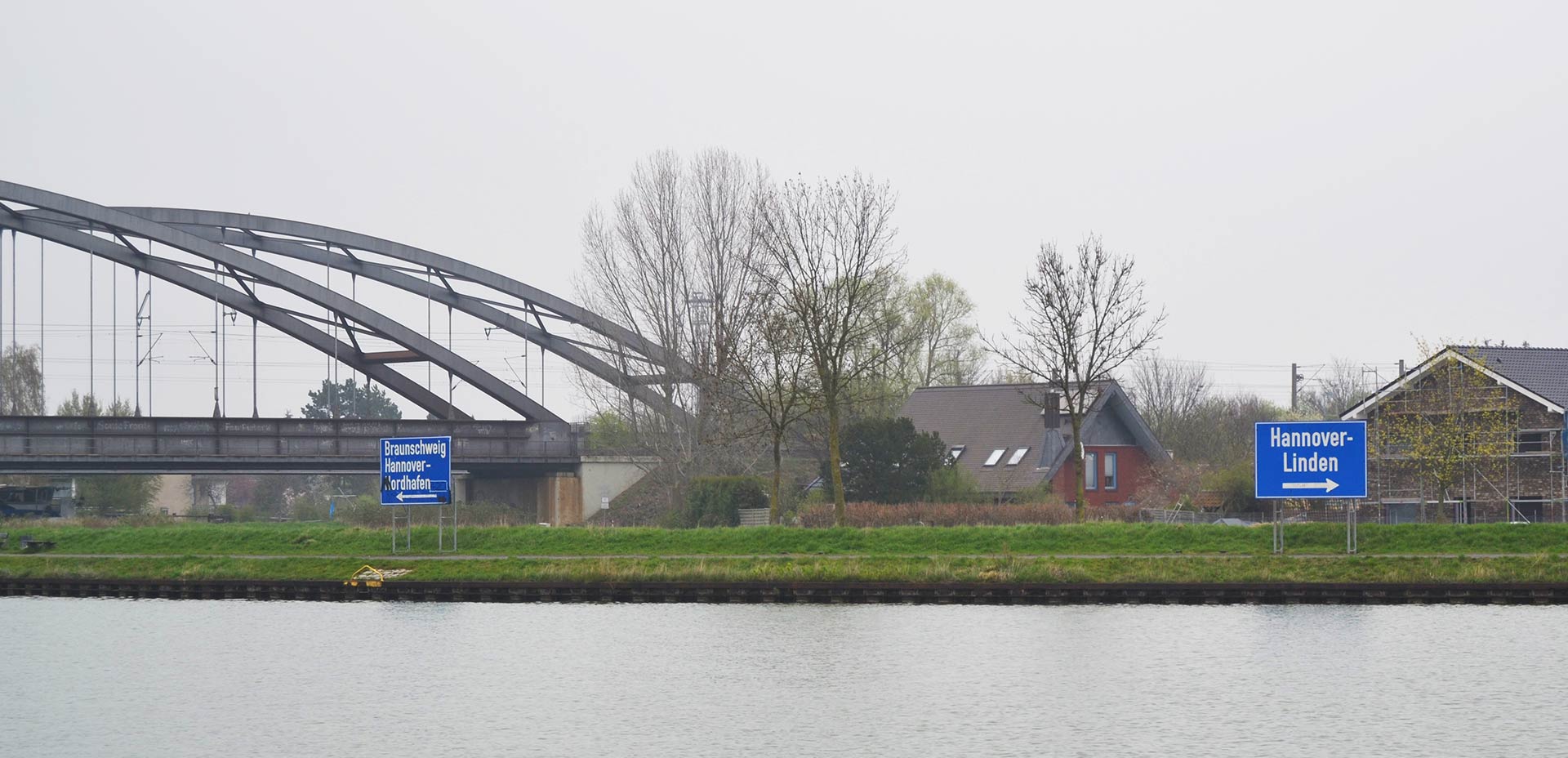
So, as we land the boat and tie her up I thank Max for being the perfect First Officer, teaching me a lot about inshore sailing, code of conduct of canal-sailing and the hints and tricks of travelling “on land” by a boat. Next time I will have a different crew and I hope it will be as smooth running as it was the past two days and 96.5 miles.
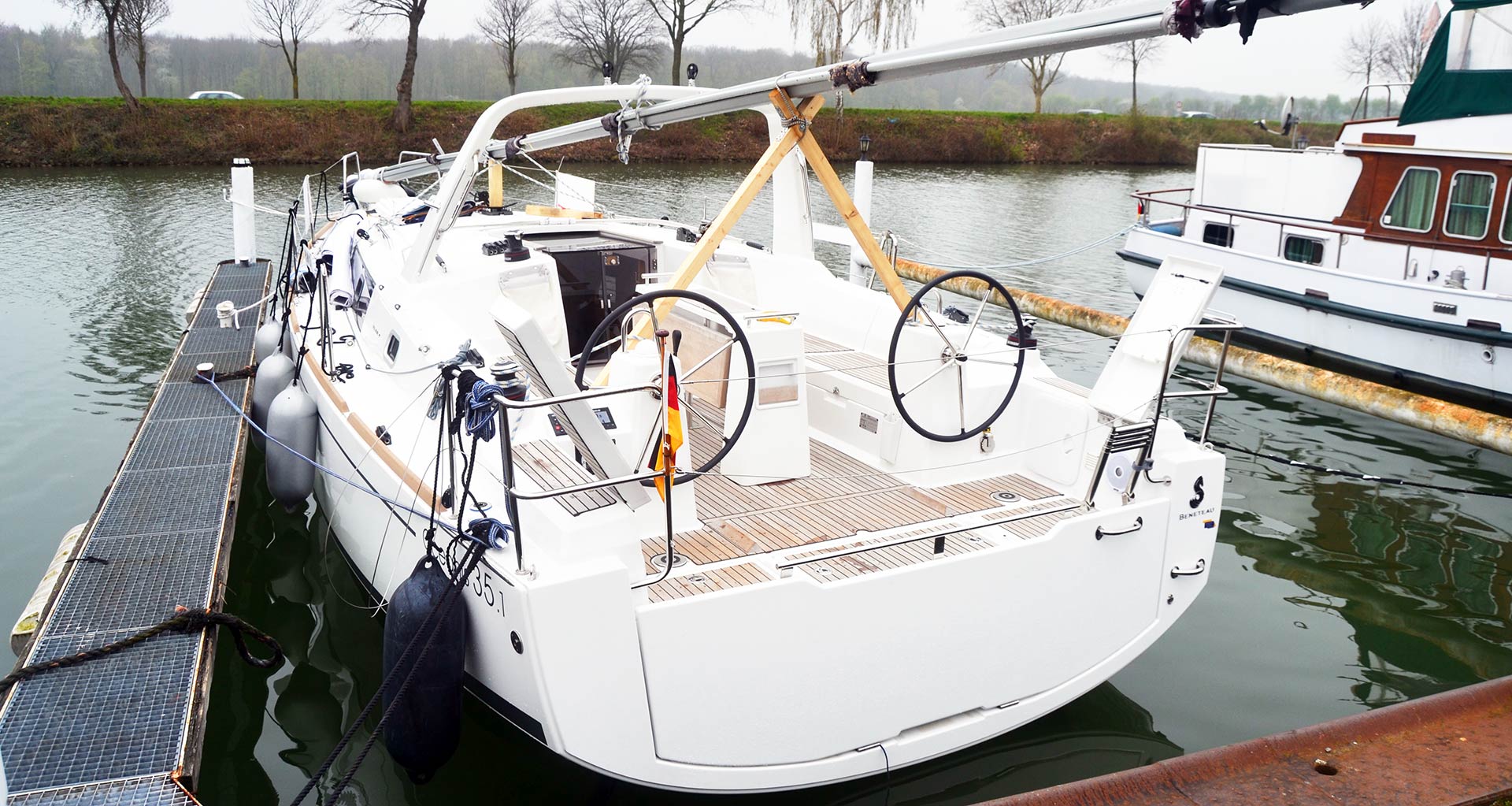
When we leave it´s barely 8 degrees Celsius and the rain is returning. We switch off the heater and clean up the boat. I just hope it will be some better suiting weather in the coming week, with myself being allowed to get out of the waterproof heavy weather sailing gear and maybe putting on some sunglasses to my nose and sun blocker to my skin. We will see …
You may read all articles related to this topic by clicking on the hashtag #inshoredelivery
Other interesting articles:
Professional delivery process of a sailing yacht
What makes a good skipper? Parts 1 and 2
Beneteau steps up a notch with their new Oceanis 46.1
